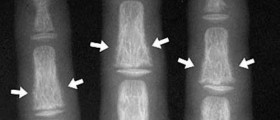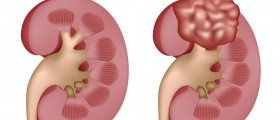
Emphysematous pyelonephritis is a condition affecting kidneys, characterized by necrosis of the renal parenchyma. There is gas formation inside the collecting system of the kidneys, renal parenchyma and sometimes even in perirenal tissue. If there is gas only inside the renal pelvis, such condition is referred to as emphysematous pyelitis.
Emphysematous pyelonephritis is a condition predominantly affecting patients suffering from diabetes. Initially symptoms and signs are quite similar to those of acute pyelonephritis but as soon as the disease progresses damage to the organ becomes more severe and patients' lives seriously jeopardized.There have not been many patients diagnosed with emphysematous pyelonephritis which makes this medical condition rather rare. Nevertheless, it needs to be diagnosed on time and treated adequately.
Emphysematous Pyelonephritis Pathophysiology
In patients suffering from this medical condition there is gas accumulation in renal tissues. There is also an underlying infection with frequently a fulminating course, especially if left untreated. Even though diabetic patients are actually susceptible to urinary tract infections, not all of them will eventually end up with emphysematous pyelonephritis. The reason behind the onset of this medical condition may be connected with uncontrolled diabetes, high levels of glycosylated hemoglobin and weakening of the immune system.
There is one more condition quite similar in presentation to emphysematous pyelonephritis called xanthogranulomatous pyelonephritis. This disease is closely related to stones in nonfunctioning kidneys affected by severe Gran-negative infection. The similarity between the two conditions is in gas production and accumulation in the renal parenchyma and perinephritic space.
Emphysematous Pyelonephritis Clinical Characteristics
Even though the condition may affect individuals between 19 and 81 years of age, it is frequently reported in patients of 55 years of age. Women are more affected than men and 95% of all patients are actually those suffering from diabetes. Other 5 % includes individuals not suffering from diabetes, those with renal failure and immunocompromised patients.
Most of the time only one kidney is affected, predominantly the left one. Patients typically develop fever and abdominal/flank pain. Nausea and vomiting may occur as well. Progression of the disease is associated with dyspnea (shortness of breath), acute renal impairment, altered sensorium and shock. Thrombocytopenia (low amount of platelets) is another characteristic of the disease.
Advanced cases of emphysematous pyelonephritis are connected with crepitus over the flank area while pneumaturia occurs only if there is emphysematous cystitis present. Rarely, one may end up with subcutaneous emphysema and pneumomediastinum.
All in all, once the diagnosis is confirmed, patients are treated in hospital environment. The treatment is aggressive.

















Your thoughts on this
Loading...